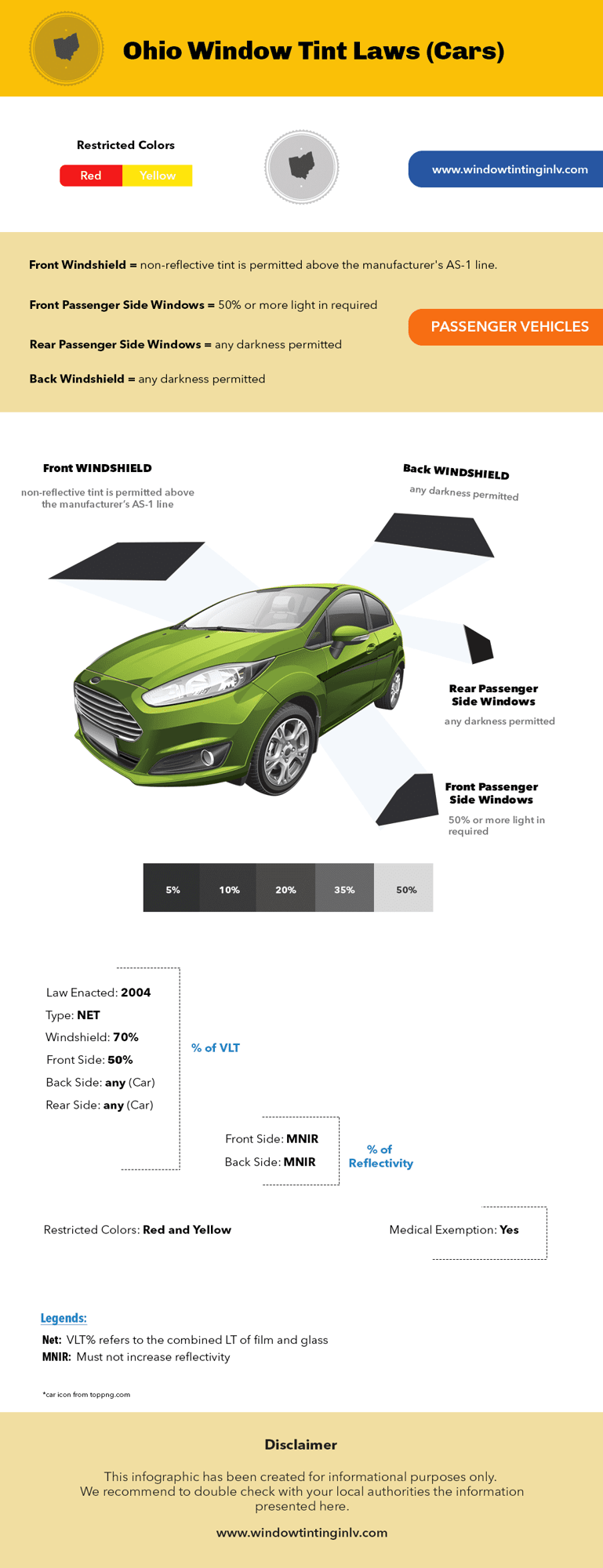
Disclaimer: As an Amazon Associate I earn from qualifying purchases.
Tinted windows are a popular design choice for personal vehicles, but they are somewhat controversial. For safety reasons, the director of public safety has the power to set regulations regarding window tint laws in Ohio.
These regulations apply to all windows in the vehicle, including the front windshields, side windows, and rear windows. Some windows have specific rules unique to their part of the car.
Here is everything you need to know about Ohio tint laws.
How Do Window Tints Work?
Window tints are shades that drivers apply to their windows to make them darker. People can use them for privacy, comfort, and style.
Always research the Ohio law before getting tinted windows.
How Are Window Tints Rated?
Window tint percentages describe how much light passes through from the outside. The higher the number, the more light passes through. The lower the number, the more dark and opaque the window is.
Window tints include the following opacities:
- 100% – No window tint. 100% of light passes through
- 70% – Somewhat transparent. Fairly usual for drivers. 70% of light passes.
- 50% – Dark. Only half of the light passes.
- 20% – Opaque window tint. Less than a quarter of light passes.
- 5% – Darkest window tint. 5% of light passes. Usually illegal for front windows.
Reflective Windows
Reflective window tints are windows that bounce light back towards the outside. These windows are essentially just mirrors.
In Ohio, reflective windows are illegal for windshields, side wings, side windows, and rear windows. You may not add reflective films or materials to your car windows.
Vehicle-Specific Ohio Window Tinting Laws Summarized
SUV and Vans
- No reflective materials may be used
- Front-side windows must allow 50% of light to pass through
- No darkness restrictions for the back side and rear windows
Sedans
- No reflective materials may be used
- Front-side windows must allow 50% of light to pass through
- No darkness restrictions for the back side and rear windows
What’s the Darkest Legal Tint in Ohio?
Each window has limits on how dark manufacturers are allowed to tint it. All manufacturers must abide by FMVSS 205. This code is the set of laws that regulate window tints in Ohio.
The darkest legal tint a regular driver can have in Ohio is 50%.
This tint only applies to their immediate side windows. If you have a legal exemption, you may legally obtain darker shades.
The law applies to all motorized vehicles, though exceptions are available for vehicles used for construction works or agriculture and motorized bicycles.


Front Windshield Tint Laws In Ohio
Drivers may tint their windshield only up to five inches below the top of it or up to the AS-1 line, whatever is closer to the top of the windshield. It is illegal to tint below this line.
The front windshield of your car may be tinted, as long as it allows 70% of light to be transmitted, with a margin of either plus or minus 3%.
In other words, 70% window tints are legal tint in Ohio for your front windshield. The law permits this tint because it is a relatively lighter shade than other tints, like 50%.
AS-1 Line Laws In Ohio
The AS-1 line is a subtle mark on your windshield beneath which no tint may be applied. This regulation is a way of keeping your view unobstructed while driving. It also allows oncoming traffic to see clearly.
Every vehicle should have one of these lines if you look closely. If you do not have an AS-1 line, contact your vehicle manufacturer.
If your AS-1 line is lower than five inches from the top of the windshield, that does not mean you can tint that far down. In this situation, you are only allowed to tint five inches beneath the top of the windshield.
Side Window Tint Laws In Ohio
The windows on either immediate side of the driver’s seat must permit no less than 50% of light to pass through. The state allows your side windows to be slightly darker than your front windshield.
Rear Window Tint Laws In Ohio
The rear window on your car may be any tint. If you want to make the rear window darker than your other windows, you are free to do so. Even opacities as dark as 5% are legal for the back window.
Any Other Windows
Window tints on any other windows of your car must be no lower than 50% transmittance. Your back side windows, however, may be any tint. These are the windows on either side of the rear passenger seats.
Color Restrictions
In Ohio, there are restrictions for red and yellow tints.
What Happens If You Are Caught With an Illegal Window Tint?
If a police officer sees you operating a vehicle with illegal window tints, they may pull you over and penalize you. Having a banned opacity is a misdemeanor in the state of Ohio.
Drivers breaking these laws are subject to fines.
How Much Is a Tint Ticket in Ohio?
Window tint fines in Ohio are usually around $120 for the first offense. If you are busted again, the penalties may increase.
Exemptions for Tinted Windows
Limos, police/government vehicles, and other special vehicles may use tints darker than the legal limit. Law enforcement vehicles generally use much darker shades than civilian vehicles. Drivers may also receive medical exemptions.
Ohio Window Tint Law Medical Exemptions
Fortunately, there are medical exemptions for people with special conditions. So, “how do I get a tint exemption in Ohio?” you may be wondering.
To obtain a medical exemption, you must have a signed affidavit from a medical professional, and it must be on your person at all times while in the vehicle.
FAQs
Is 5% tint legal in Ohio?
Five percent tint is only legal in certain windows: the rear window and the windows on each side of the rear passenger seats.
Is 20% tint legal in Ohio?
You can only apply 20% tint to the back window or to the back side windows.
Is 35% window tint legal in Ohio?
The rules for 35% window tint are the same as for 5% or 20%. You can only apply it to the back window or back side windows.
Tint Laws Ohio | Wrap-Up
Window tint laws in Ohio state that It is illegal to sell, manufacture, or drive any vehicle that does not abide by these laws. It is important to always review the law so you can avoid legal or safety concerns in the future. Stay safe!
References
State Window Tinting Rules & Laws
Ohio Administrative Code – Rule 4501-41-03
Check Out Other States Window Tint Laws:
Window Tint Law In California
Texas Window Tint Laws
Nevada Window tinting Laws
Window Tint Laws in Florida
Window Tint Law in Virginia
North Carolina Window Tint Laws
Pennsylvania Tint Laws
Window Tint Law In Illinois
Window tint Law In Georgia
Michigan Window tint Laws